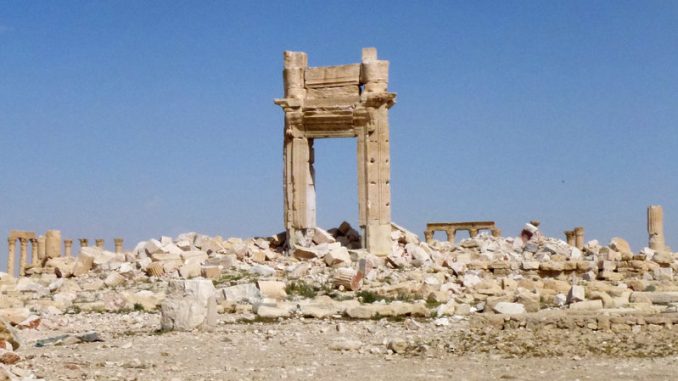
After the recent horrific destruction by ISIS militants, Palmyra’s Temple of Bel may not be lost forever. Though the full extent of the damage to the ancient temple is unknown, many believe that it can be rebuilt.
Reuters says:

BYPASS THE CENSORS
Sign up to get unfiltered news delivered straight to your inbox.
You can unsubscribe any time. By subscribing you agree to our Terms of Use
Latest Video
Satellite pictures taken after the 2,000-year-old temple was dynamited by the jihadi group, and other images broadcast since Syrian government forces retook the city on Sunday, show almost the entire structure collapsed in a heap of rubble.
It was one of several important monuments blown up in the city last year including the temple of Baal Shamin, a victory arch and funerary towers. The city museum, home to treasured artifacts, was ransacked and statues were smashed or defaced.
Despite the extensive damage, Maamoun Abdelkarim said that the Temple of Bel had not been pulverized and its foundations were largely intact.
Consecrated to a Mesopotamian god, the Temple of Bel later served as a Christian church and a mosque. In an inner sanctuary, carvings showed seven planets surrounded by the signs of the zodiac, and a procession of camels and veiled women.
“What was said about it all being turned to dust – it’s not dust,” Abdelkarim told Reuters in Damascus. “There is still a lot of the structure … that can be reused and renovated.”
He was speaking before a trip to Paris where he said he would attend a meeting of the United Nations cultural agency UNESCO and seek global help to restore Palmyra. President Bashar al-Assad called on the world on Wednesday to help.
Syrian military engineers were already combing the area for mines which Islamic State are suspected of leaving behind amid the ruins, he said.
Russian de-mining units, using robots and sniffer dogs, have also arrived in Syria to start clearing the area, in the latest support from Moscow to Assad, its Middle Eastern ally.
Russia’s military intervention six months ago helped change the course of Syria’s five-year-old conflict in Assad’s favor, reversing last year’s gains by insurgents and Western-backed rebels in northwest Syria, before assisting an assault on Palmyra opening up Syria’s eastern desert to government forces.
The Western response to Sunday’s recapture of Palmyra has been muted. While some governments have welcomed the setback for Islamic State, they are reluctant to celebrate any victory for a president whose departure many of them demanded five years ago.
TREASURE AND GOLD
Islamic State has also razed Assyrian and Roman-era cities in neighboring Iraq – driven by a radical ideology which deems the region’s pre-Islamic heritage as idolatrous and by the lure of profit from selling stolen artifacts.
Other monuments in the oasis city, described by UNESCO as a crossroads of cultures since the dawn of humanity and a major source of interest for archaeologists, historians of the ancient world and tourists, remain including its Roman amphitheatre and long colonnaded avenue.
Officials have inspected damage at Palmyra’s museum, where a 15-tonne statue of a lion holding a crouching gazelle, known as the Lion of Al-Lat, was found broken in the grounds of the building, Abdelkarim said. The statue has already been restored once after it was broken up in antiquity to build another temple.
Abdelkarim said 400 artifacts had been moved from the site for safekeeping before Islamic State overran Palmyra last May, but television images from the museum have shown statues defaced or broken and display cases smashed up.
“Daesh were looking for treasure and gold – they thought there would be tonnes of gold. There was none, because the main articles had been moved to Damascus,” he said
Describing the headless or defaced carvings, Abdelkarim compared the restoration work they would undergo to the surgery performed on patients with serious burn injuries.
“You undergo many surgeries and your face won’t come back as it was, but you’re still alive,” he said.
RUSSIAN DE-MINER ROBOTS
The de-miners will deal with more than 180 hectares of territory, Russia’s defense ministry said, citing initial estimates. The aim is to clear the historic part of the ancient city as well as residential areas.
Their work is complicated by the fact that the retreating Islamic State fighters “left a large quantity of various homemade explosive devices behind them in Palmyra as well as standard mines”, the ministry said.
Abdelkarim said the militants had “a plan to destroy the city” but did not go through with it.
In Palmyra, Islamic State carried out excavations, hunting for buried artifacts, but Abdelkarim said it was too early to say how much digging or damage they had done.
“We cannot evaluate the destruction to the ruins from the criminal secret excavations … It will take weeks to assess,” he said, given that big parts of the old city are inaccessible.
“We have been into the museum and to the Temple of Bel, the amphitheatre, and the colonnaded street,” Abdelkarim said, adding: “But where there is sandy ground we cannot go … because there could be mines.”
The overall task of clearing Palmyra, which military sources have told Russian media will involve at least 100 servicemen, is expected to take several months.
Russian forces will draw on their extensive experience of de-mining in the volatile North Caucasus region where a low-level Islamist insurgency has been simmering for years.
For the toughest tasks, the Russians said they would use sniffer dogs and Uran-6 de-mining robots, which can be remotely controlled from around 1 km (half a mile) and do the work of 20 de-mining experts.


